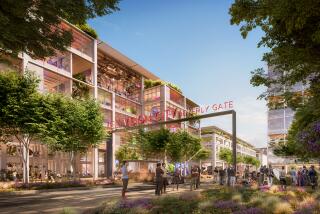City’s Future Growth Hinges on Restraint by Both Sides
- Share via
Under the Los Angeles general plan, intense commercial development is to be concentrated in numerous, loosely defined “centers” theoretically linked by freeways or mass transit.
But in practice the pressures to develop commercial projects in the city’s more desirable areas--downtown, Westwood, West Los Angeles, the international airport area, Warner Center and other locations in the San Fernando Valley--may be more the result of a neighborhood’s ambiance than planning efforts.
Indeed, a good climate and physical environment, an accessible work force, urban affluence, a stable local government and a vibrant, capitalistic spirit seem to be the factors that determine an area’s desirability and bring on intense development. In the less desirable or poorer parts of Los Angeles--South-Central, East L.A., the Harbor Freeway corridor, Wilmington and many portions of the central city--zoning patterns are almost irrelevant and governmental subsidies are needed to stimulate quality commercial development.
All this is important to consider when looking at the city’s future, particularly what direction the city should go if the decade-long downtown boom is indeed beginning to slow down.
The theory of the general plan is that if development slows in one center, such as downtown, it will shift to others, thus keeping the city’s economic engine running at full throttle. This notion is somewhat unrealistic, however, because downtown has become the region’s financial center, attracting corporations, banks and trading institutions. Law firms, accounting firms, consultants and real-estate enterprises have followed. These businesses most likely will not be attracted to smaller, more remote centers.
But because of the city’s attractiveness, development should continue, particularly in the more desirable centers. The question is: Will such growth be allowed to proceed?
Various community groups--some thoughtful and concerned, others nihilistic and myopic--are fighting tooth and nail to stop nearly all development in many areas planned for large or moderate growth.
While there is merit to some of these efforts, opponents of growth should not forget one lesson that the city has learned: Regulations by themselves do not, and cannot, stop building.
Beginning with the massive downzoning and replanning of Century City, Los Angeles has unleashed a blizzard of regulatory activity affecting land use. Yet growth goes on as our economy expands.
Meanwhile, the confrontation between development and anti-development forces continues, making it even more difficult to enact rational, balanced citywide planning policies.
Downtown’s success was due in part to the absence of an organized, vocal, affluent resident group opposing new development. As a result, government was free to develop a policy designed to stimulate the economy through massive commercial development.
Now this period of dynamic growth has slowed. What the future brings for downtown and the rest of Los Angeles depends greatly on the vision and courage of not only our elected officials but also many of our community groups.
If the NIMBYs--those who say “not in my back yard”--win, the economic growth of the region will slow with resulting joblessness and a diminution of entrepreneurial opportunities.
If developers build without restraint or if less responsible lobbyists persuade state or federal authorities to eliminate many local restrictions, our quality of life will be threatened by unacceptable levels of traffic and smog.
The initiative campaign that was begun recently by Councilmen Marvin Braude and Zev Yaroslavsky, which I support, promotes the centers concept. It allows more intense development to occur in the city centers while reducing commercial capacity in other parts of Los Angeles to more reasonable levels. It does not stop development, but rather directs it to appropriate locations. Follow-up legislation will be required to allow greater flexibility for lots that would come under size restrictions but are located in centers or enterprise zones. Nonetheless, the initiative, if passed, will hinder huge developments from being built on top of single-family neighborhoods.
Measures like this point the way to a new era for Los Angeles. Those who can balance competing forces and at the same time conceive of and implement intelligent citywide policies will be the leaders of this new era.
More to Read
Sign up for Essential California
The most important California stories and recommendations in your inbox every morning.
You may occasionally receive promotional content from the Los Angeles Times.










